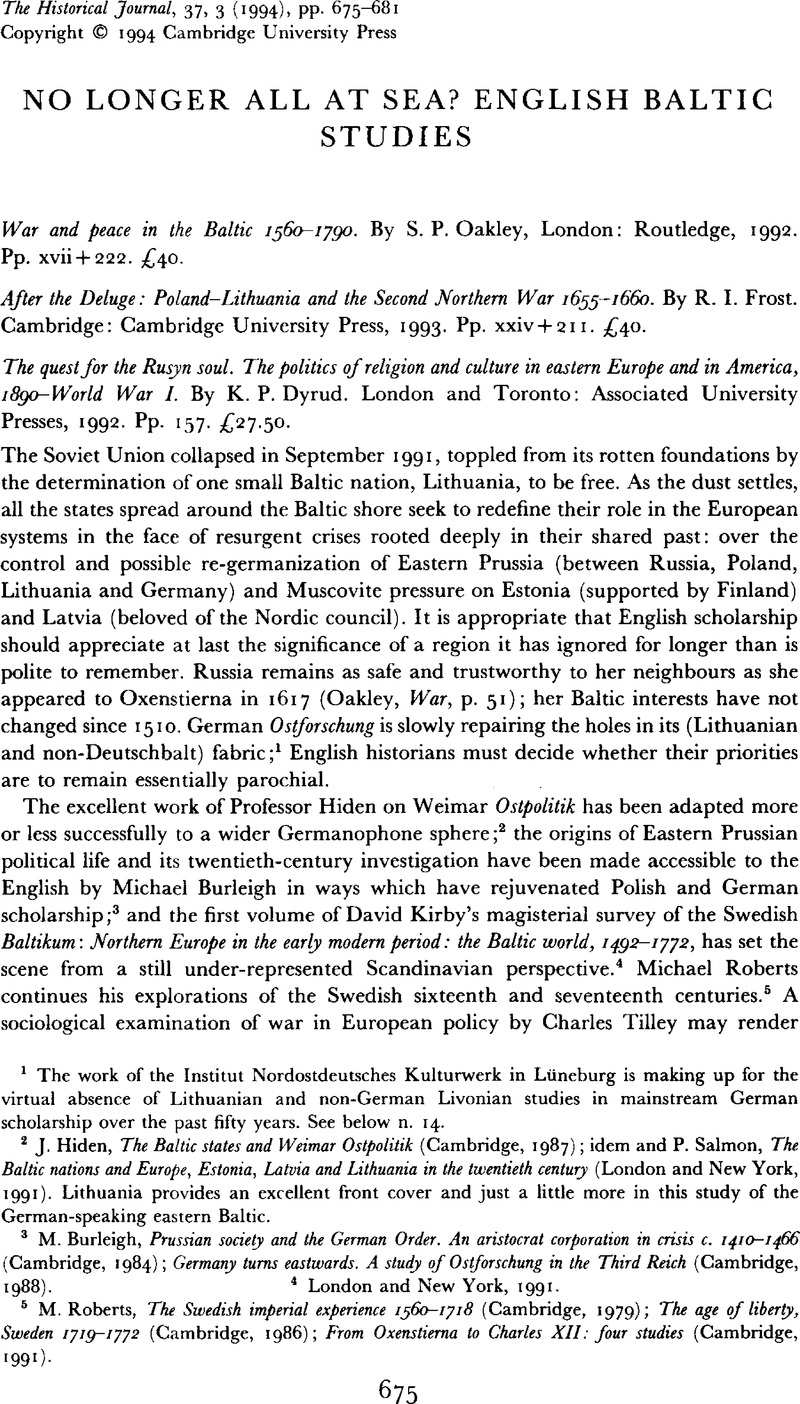No CrossRef data available.
Article contents
No longer all at sea? English Baltic studies
Published online by Cambridge University Press: 11 February 2009
Abstract

- Type
- Review Articles
- Information
- Copyright
- Copyright © Cambridge University Press 1994
References
1 The work of the Institut Nordostdeutsches Kulturwerk in Lüneburg is making up for the virtual absence of Lithuanian and non-German Livonian studies in mainstream German scholarship over the past fifty years. See below n. 14.
2 Hiden, J., The Baltic states and Weimar Ostpolitik (Cambridge, 1987)CrossRefGoogle Scholar; idem and Salmon, P., The Baltic nations and Europe, Estonia, Latvia and Lithuania in the twentieth century (London and New York, 1991)Google Scholar. Lithuania provides an excellent front cover and just a little more in this study of the German-speaking eastern Baltic.
3 Burleigh, M., Prussian society and the German Order. An aristocrat corporation in crisis c. 1410–1466 (Cambridge, 1984)Google Scholar; Germany turns eastwards. A study of Ostforschung in the Third Reich (Cambridge, 1988).Google Scholar
4 London and New York, 1991.
5 Roberts, M., The Swedish imperial experience 1560–1718 (Cambridge, 1979)CrossRefGoogle Scholar; The age of liberty, Sweden 1719–1772 (Cambridge, 1986)Google Scholar; From Oxenstierna to Charles XII: four studies (Cambridge, 1991).Google Scholar
6 Tilley, C., Coercion, capital and the European states AD 990–1992 (Cambridge, MA and Oxford, 1990).Google Scholar
7 War in context (London, 1992–). ed. Black, J..Google Scholar
8 Kirby, , Northern Europe, p. XGoogle Scholar. Bonney, R., The European dynastic states 1494–1660 [The short Oxford history of the modern world] (Oxford, 1991), pp. 242–301 deals with ‘the outsiders of Europe’ by which curious misnomer he refers to Sweden, Poland–Lithuania, Russia and the Ottoman empire. Some English readers may understand the jargon sympathetically as ‘not my period, not my bailiwick’; would anyone else? The Winds of the World give answer!Google Scholar
9 Oakley, S.P, The story of Sweden (London, 1966)Google Scholar; The story of Denmark (London, 1972)Google Scholar; William III and the northern crowns during the Mine Years War 1689–1697 (London and New York, 1987).Google Scholar
10 Gudavičius, E., ‘Lietuvių pašauktinės kariuomenės organizacijos bruožai’ [‘Outlines of Lithuanian military conscription’], Karo Archyvas, XIII (1992), 43–118Google Scholar; Wimmer, J., ‘Wojsko i skarb Rzeczypospolitej u schylku XVI i w I polowie XVII w.’, Stadia i materialy do Historii Wojskowości, XIV (1966) and the studies of M. Nagielski.Google Scholar
11 Towarzystwo Naukowe w Toruniu, responsible for Zapiski Historyczne since 1908.
12 Acta Poloniae Historica (Warsaw, 1958–) provides translations in western European languages of selected Polish papers each year.Google Scholar
13 For sixteenth-century Russia see the works of R. G. Skrynnikov. E. Keenan and the North American school of sixteenth- and seventeenth-century Muscovite history have amplified N. Andreyev's work in Cambridge several decades ago. A more useful summary than that available here is given by Crummey, R. O., The formation of Muscovy 1304–1613 (London and New York, 1987)Google Scholar. At least read Angermann, N., Studien zur Livlandpolitik Ivan Groznyjs (Marburg/Lahn, 1972).Google Scholar
14 Jahrbücher für Geschichte Osteuropas (Breslau, 1936–1941Google Scholar; Munich, 1953–) Zeitschrift für Ostfurschung (Marburg/Lahn, 1952–)Google Scholar; Nordost-Archiv. Zeitschrift für Regionalgeschichle, new series I– (Lüneberg, 1992– )Google Scholar; the series Studien zum Deutschtum im Osten (Cologne and Vienna).
15 Lietuvos TSR Mokslų Akademijos Darbai, Series A [now Lituanistica] (Vilnius, 1958–)Google Scholar; Lietuvos Istorijos Metraštis (Vilnius, 1973–).Google Scholar
16 The chronicle of Balthasar Russow and a forthright rebuttal by Elert Kruse and Errors and mistakes Balthasar Russow by Heinrich Tisenhausen tr. Smith, J. C., Eichhoff, J. and Urban, W. L., Wisconsin Baltic Studies, II (1988) and Salomon Henning's Chronicle of Courland and Livonia, tr., intro., notes, Smith, J. C., Jones, J. Ward and Urban, W. L., Wisconsin Baltic Studies, in (Madison WI, 1992).Google Scholar
17 Backus, O. P., ‘The problem of unity in the Polish-Lithuanian state’, Slavic Review, XXII (1963). 411–41.CrossRefGoogle Scholar
18 Tyla, A., ‘Žemaitija Lietuvos išlaisvinimo kare 1655–61 m.’ [‘Zemaitija in the fight for Lithuanian liberation 1655–61’], Žemaičių Praeilis, 1 (Vilnius, 1990), 99–110Google Scholar; Borščiakas, E., ‘Ukraina, Lietuva ir prancūzų diplomatija 1648–1657 metais’ [‘The Ukraine, Lithuania and French diplomacy 1648–57’], Praeilis, III (ed. Kaunas, , 1941, pub. Vilnius, 1992), 126–53Google Scholar; cf. Šapoka, A., 1655 metų Kėdainių sutartis, arba švedai Lietuvoje 1655–56 metais, ed. Tyla, A. [The treaty Kėdainiai, 1655 or: the Swedes in Lithuania 1655–56] (Vilnius, 1990).Google Scholar
19 Vilnius: Mokslo ir enciklopédijų leidykla, 1993, with German and Polish summaries, pp. 253–262–270.
20 Bonkalo, A., The Rusyns, tr. Bonkalo, E. [East European Monographs 293] (New York, 1990)Google Scholar, a triumphalist celebration of Hungarian seizure of Sub-Carpathian Ruthenia from Czechoslovaks in 1940; Pekar, A. B., The history of the church in Carpathian Rus' (New York, 1990)Google Scholar both in the series Classics of Carpatho-Rusyn scholarship, eds. A. Krafcik and P. R. Magocsi. Cf. Simon, K., ‘Alexis Toth and the beginnings of the Orthodox movement among the Ruthenians in America (1891)’, Orientalia Christiana Periodica, LIV, 2 (1988), 387–428.Google Scholar


